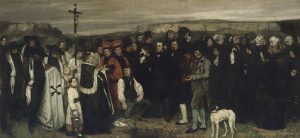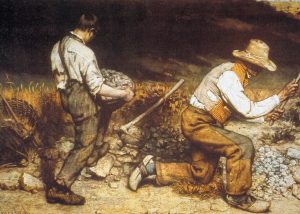By Colorado Review Editorial Assistant Geneva McCarthy
It’s no accident that I’m taking an art history course while pursuing an MFA in poetry; rather, it points to my interest in the conversation between mediums. While this may seem a sidelong approach, it has been, in conjunction with my work as at the Center for Literary Publishing and my own writing’s interests, an illuminating lens.
 One of the things I’ve come to understand about artistic pursuits, or at least about mine, is that they are anything but linear. Sometimes one needs to push the limits only to retrace origins and vice versa. So it is that I began exploring seemingly oppositional forces at play in art in general, and subsequently, in written mediums. I’ll ask your forgiveness, due to obvious constraints of time and length, for what is a crash course and likely highly reductive summary of art’s evolution in the nineteenth century.
One of the things I’ve come to understand about artistic pursuits, or at least about mine, is that they are anything but linear. Sometimes one needs to push the limits only to retrace origins and vice versa. So it is that I began exploring seemingly oppositional forces at play in art in general, and subsequently, in written mediums. I’ll ask your forgiveness, due to obvious constraints of time and length, for what is a crash course and likely highly reductive summary of art’s evolution in the nineteenth century.
In an effort to maintain authority in ever-increasing turbulent times, politically and socially speaking, King Louis XIV latched onto ancient formal features when he instituted the Académie Royale de Peinture et de Sculpture, hoping the inherited forms of long-standing civilized cultures would substantiate his right to rule as divinely appointed. However, certain artists (beginning approximately with Jacques-Louis David in the 1780s) began to feel the tension between being commissioned to further a monopolistic hold on art (after all, only those with money and clout could afford to commission artwork), and the Enlightenment thinking that challenged the primacy of rule as estranged from that of all the members of a given society. Industrialism eventually aided this as the balance of power shifted, ever so slightly, toward an increasing middle class. As many artists were members neither of the upper class nor of the lowest (due to the rigid social stratification of the times), this distinction and consideration put them rather squarely between oppositional ideological forces.
Across time, the inherited became conflated with antiquated, nonprogressive, or oppressive, and the new associated with a common or public voice. Gustave Courbet, with his massive trio of paintings for the Paris Salon in 1850-51 that both depicted commoners and used techniques less royally sanctioned and codified, distilled the disparity in image. The Stone Breakers, for instance, doesn’t show the faces of the workers, but posits them in thankless labor, wearing tattered clothes. While rendered in traditional heroic fashion, the figures appear locked in mechanistic repetition, and Courbet’s brushstrokes parallel the workers’ rough-hewn reality, rather than in a glossy, perfected finish. After about sixty-five years of incremental change in art, Courbet had finally given body and representation to a subset traditionally made invisible. 
Some working in the medium of words sought to achieve a similar equality of art, in subject, diction, inherited forms like sonnets, and sonic qualities like rhyme and meter. Others valued inherited forms, though not exclusively as a consequence of ideology or aesthetics necessarily, and herein is the seeming bifurcation. To be clear, the intent wasn’t to make inherited art forms or techniques bad (Courbet didn’t abandon all his classical training), but to broaden art’s scope to include more than the perspective and ideals of just the ruling class, to trouble those associations of ideology and aesthetics, and to introduce more varied thinking. This brings up the question of art’s role in society, depending on one’s particular time and place, geographically and culturally. I find the tethering of ideology and aesthetics an area of particular curiosity, how one generation’s notions continue to influence or recede according to fluctuations in societal pressures and issues. The influence of what we publish, therefore, also has the ability to have an impact on the future.
Just as Courbet’s works would have no significance if not viewed through what had come before, writing also occupies that peculiar notion of present, by finding relation (or difference) between past and future. Along the way, some writers have resurrected elements of past writings, while others have made language itself the crucible, and others still have chosen to continue pushing against the ideological paradigm created by a French monarch in 1648 (especially in realms where equality feels disproportionately allotted—marginalization, sadly, has many forms).
I’m fascinated by these intersections and how they manifest in the spectrum of works we receive and read. I’m particularly drawn to pieces in which the past and present engage with one another. What some might view as oppositional, I frame more through a lens that encompasses multiplicity. Language is a medium of both communication and expression, but art isn’t static; it’s a living, changing discourse on what it is to be human, and having the privilege to hear the many voices speaking in or to that exchange is exhilarating. As an added personal bonus, reading submissions offers me the ability to understand how my voice might join humanity in the long and varied conversation that is the written word.